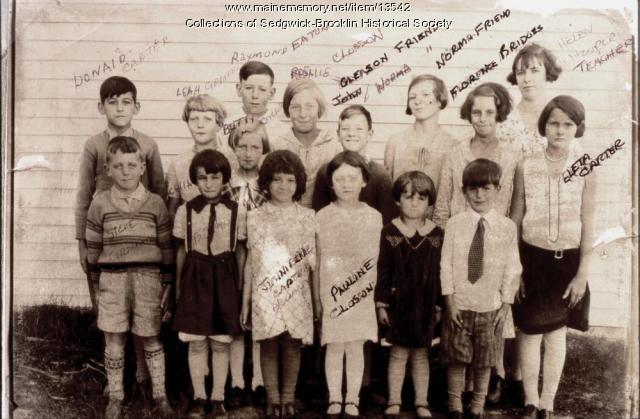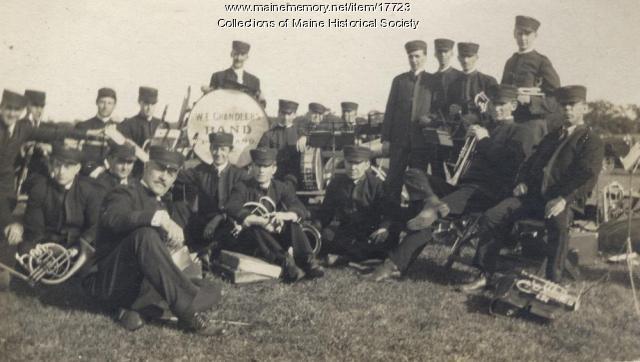Keywords: family home
- Historical Items (1552)
- Tax Records (8118)
- Architecture & Landscape (14)
- Online Exhibits (174)
- Site Pages (488)
- My Maine Stories (103)
- Lesson Plans (3)
Online Exhibits
Your results include these online exhibits. You also can view all of the site's exhibits, view a timeline of selected events in Maine History, and learn how to create your own exhibit. See featured exhibits or create your own exhibit
Exhibit
Passing the Time: Artwork by World War II German POWs
In 1944, the US Government established Camp Houlton, a prisoner of war (POW) internment camp for captured German soldiers during World War II. Many of the prisoners worked on local farms planting and harvesting potatoes. Some created artwork and handicrafts they sold or gave to camp guards. Camp Houlton processed and held about 3500 prisoners and operated until May 1946.
Exhibit
Princeton: Woods and Water Built This Town
Princeton benefited from its location on a river -- the St. Croix -- that was useful for transportation of people and lumber and for powering mills as well as on its proximity to forests.
Exhibit
From Sewers to Skylines: William S. Edwards's 1887 Photo Album
William S. Edwards (1830-1918) was a civil engineer who worked for the City of Portland from 1876-1906. Serving as First Assistant to Chief Engineer William A. Goodwin, then to Commissioner George N. Fernald, Edwards was a fixture in City Hall for 30 consecutive years, proving indispensable throughout the terms of 15 Mayors of Portland, including all six of those held by James Phineas Baxter. Edwards made significant contributions to Portland, was an outstanding mapmaker and planner, and his works continue to benefit historians.
Exhibit
Begin Again: reckoning with intolerance in Maine
BEGIN AGAIN explores Maine's historic role, going back 528 years, in crisis that brought about the pandemic, social and economic inequities, and the Black Lives Matter movement in 2020.
Exhibit
Lillian Nordica: Farmington Diva
Lillian Norton, known as Nordica, was one of the best known sopranos in America and the world at the end of the nineteenth and beginning of the twentieth centuries. She was a native of Farmington.
Exhibit
Reading, Writing and 'Rithmetic: Brooklin Schools
When Brooklin, located on the Blue Hill Peninsula, was incorporated in 1849, there were ten school districts and nine one-room school houses. As the years went by, population changes affected the location and number of schools in the area. State requirements began to determine ways that student's education would be handled. Regardless, education of the Brooklin students always remained a high priority for the town.
Exhibit
Maine Through the Eyes of George W. French
George French, a native of Kezar Falls and graduate of Bates College, worked at several jobs before turning to photography as his career. He served for many years as photographer for the Maine Development Commission, taking pictures intended to promote both development and tourism.
Exhibit
Jameson & Wotton Wharf, Friendship
Since 1897, the Jameson & Wotton Wharf in Friendship has been an important addition to the community on Muscongus Bay. The wharf, which is accessible at all tides, was a steamboat stop for many years, as well as important to the lobster business.
Exhibit
Waldoboro Fire Department's 175 Years
While the town of Waldoboro was chartered in 1773, it began organized fire protection in 1838 with a volunteer fire department and a hand pump fire engine, the Water Witch.
Exhibit
Father John Bapst: Catholicism's Defender and Promoter
Father John Bapst, a Jesuit, knew little of America or Maine when he arrived in Old Town in 1853 from Switzerland. He built churches and defended Roman Catholics against Know-Nothing activists, who tarred and feathered the priest in Ellsworth in 1854.
Exhibit
Rum, Riot, and Reform - Drinking: Elegance and Debauchery
"It was owned by a Portland doctor and his family. X Coaster American, probably New York, 1855-1860 Silver and birds eye maple; silver…"
Exhibit
Biddeford, Saco and the Textile Industry
The largest textile factory in the country reached seven stories up on the banks of the Saco River in 1825, ushering in more than a century of making cloth in Biddeford and Saco. Along with the industry came larger populations and commercial, retail, social, and cultural growth.
Exhibit
A fire and two men whose lives were entwined for more than 50 years resulted in what is now considered to be "the Jewel of Portland" -- the Austin organ that was given to the city of Portland in 1912.
Exhibit
A Convenient Soldier: The Black Guards of Maine
The Black Guards were African American Army soldiers, members of the segregated Second Battalion of the 366th Infantry sent to guard the railways of Maine during World War II, from 1941 to 1945. The purpose of the Black Guards' deployment to Maine was to prevent terrorist attacks along the railways, and to keep Maine citizens safe during the war.
Exhibit
Westbrook Seminary: Educating Women
Westbrook Seminary, built on Stevens Plain in 1831, was founded to educate young men and young women. Seminaries traditionally were a form of advanced secondary education. Westbrook Seminary served an important function in admitting women students, for whom education was less available in the early and mid nineteenth century.
Exhibit
Horace W. Shaylor: Portland Penman
Horace W. Shaylor, a native of Ohio, settled in Portland and turned his focus to handwriting, developing several unique books of handwriting instruction. He also was a talented artist.
Exhibit
Silk Manufacturing in Westbrook
Cultivation of silkworms and manufacture of silk thread was touted as a new agricultural boon for Maine in the early 19th century. However, only small-scale silk production followed. In 1874, the Haskell Silk Co. of Westbrook changed that, importing raw silk, and producing silk machine twist threat, then fabrics, until its demise in 1930.
Exhibit
George Popham and a group of fellow Englishmen arrived at the mouth of the Kennebec River, hoping to trade with Native Americans, find gold and other valuable minerals, and discover a Northwest passage. In 18 months, the fledgling colony was gone.
Exhibit
Before the era of recorded music and radio, nearly every community had a band that played at parades and other civic events. Fire departments had bands, military units had bands, theaters had bands. Band music was everywhere.
Exhibit
History in Motion: The Era of the Electric Railways
Street railways, whether horse-drawn or electric, required the building of trestles and tracks. The new form of transportation aided industry, workers, vacationers, and other travelers.
Exhibit
The history of the region now known as Maine did not begin at statehood in 1820. What was Maine before it was a state? How did Maine separate from Massachusetts? How has the Maine we experience today been shaped by thousands of years of history?
Exhibit
Maine Streets: The Postcard View
Photographers from the Eastern Illustrating and Publishing Co. of Belfast traveled throughout the state, especially in small communities, taking images for postcards. Many of these images, taken in the first three decades of the twentieth century, capture Main Streets on the brink of modernity.
Exhibit
Student Exhibit: Historic Buildings on Madison Ave in Skowhegan
Take a tour and see some of the beautiful old buildings that used to be on Madison Avenue, Skowhegan? A few still remain, but most have been torn down.
Exhibit
CODE RED: Climate, Justice & Natural History Collections
Explore topics around climate change by reuniting collections from one of the nation's earliest natural history museums, the Portland Society of Natural History. The exhibition focuses on how museums collect, and the role of humans in creating changes in society, climate, and biodiversity.
























